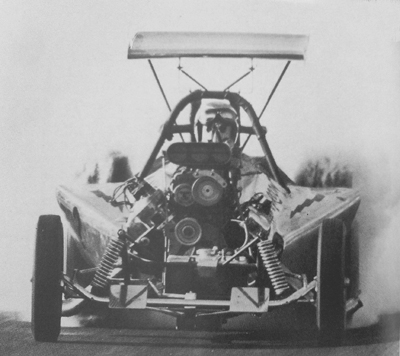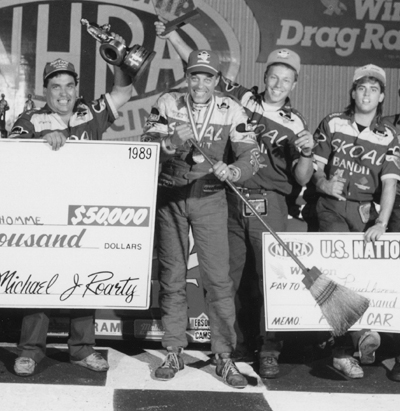

Bet you're pretty tired of the streamliner stuff, but...
So, there we were, enjoying brewskies and fine bench racing at the annual Scott Kalitta memorial get-together in the Kalitta pit Saturday night in E-town. One well-lubricated PR type, a self-professed big fan of the column, leaned over and said something on the order of, "I know all I need to know about wedge dragsters … it's time to move on, Phil."
 |
As much as I have enjoyed – and been amazed at the lifespan of – this extended segue into a relatively minor part of our sport's history, I'm inclined to agree. Too bad other readers don’t feel that way yet. The headline for today's column is directly from the subject line of an e-mail from one of them, longtime National DRAGSTER lensman Richard Brady, who sent this shot of Lou Patane's aerodynamically enhanced Top Fueler from 1979. The snout is certainly reminiscent of the Jim and Alison Lee car featured here last week
He noted, "While scanning all my old stuff and being able to see some of the stuff I took way back when, I ran across this shot from the AHRA Winter Nationals in 1979! I was on my way to Pomona, of course, and driving as usual, or in this case riding with George Williams, who was running in Stock eliminator with his Z/Stock four-speed Vega! While not a true streamliner as all your other cars pictured, I thought then as I do now that this car had some added things to the body that made it pretty swoopy, for its time at least!"

 |
Shades of Jim Dunn!: Thomas Naccarato sent the interesting photo at right of late flopper star "Flash Gordon" Mineo running a decidedly not Funny Car, which I had seen and the circumstances of which I was vaguely familiar, and he also shared a clipping from a magazine that explains the photo.
Mineo's Funny Car had been damaged a few weeks earlier when his car got airborne in the lights (at Fremont, I believe), destroying the body. The Texas racer, anxious not to miss any dates, added a wing and brief body panels to his Funny Car chassis and went Top Fuel racing. He smoked his way to a 7.01 that qualified him well in the Lions Top Fuel field. There's no mention of how well he did, but it sure made for an interesting-looking piece.

 |
In the item on the Lees' Top Fueler, I noted the early aerodynamic appendages on the side of the car just in front of the rear tires and surmised that they were early versions of the common "mud flaps" on today's Top Fuelers. I was thrilled to hear from longtime and respected nitro crewmember Dana Kimmel on the subject. Kimmel was a crewmember on Don "the Snake" Prudhomme's Skoal Bandit Top Fueler, which seems to be ground zero for the modern-day units. (At right is a photo from the winner's circle at "Snake's" 1989 Indy/Shootout Funny Car double; Kimmel is at left holding the Wally, and Mike Kloeber and crewmember Larry Dixon are at right. That was some good team.)
"The wedge storyline you are pursuing is approaching the 1990 debut of the now-common 'Eaker flaps,' or mud flaps, as they were more commonly called," he wrote. "These common accessories were designed, built, and tested in about 30 minutes at the NRC Lab Ottawa just days prior the Montreal race where 'Snake' crashed in yet another incident of the forgettable 1990 return to Top Fuel season.
"The story of the flaps was a simple one. We were testing the use of canard wings just behind the driver, and after about three tests, the NRC engineers suggested we turn them up over 45 degrees to see some positive results. Pontiac’s Gary Eaker (of the GM Aero Lab), who was overseeing the project, suggested we just add flat plates and lose the wings. So myself, Larry Dixon, and Willy Wolter went off to the fab shop within the wind-tunnel facility and sheared out the pieces needed. The existing body panel dictated the angle, and a break in the large square part allowed it to pick up the two existing Dzus fastener holes. The triangle piece was cut to fit, and the whole assembly was taped together for the next series of tests. Not very scientific, but a solid approach that yielded a big return in offsetting the 1,000-plus lift generated by the rear tires.
 |
"We ran the first test with no wing front or rear to ascertain the true characteristics of a Top Fuel chassis, which in this case was a brand-new Al Swindahl car (which expired days later in its first race at Sanair). Other areas we tested that day were skinning the rear wing stands so it appeared like a twin-tailed F-14 to test the stabilizing effect of the 'tails' when yawing the car varying amounts. That test was conclusive enough to reveal a rear vertical stabilizer really had no positive effect until the car was far enough sideways that you could read the sponsor’s name. This was due to the poor airflow past the engine, etc., and it was concluded the drag incurred by the rear wing was way more of an influence on directional stability than the tails would be. Think way bigger if you are wanting a functional tail on your fuel dragster. Anyway, the pictured mud flaps debuted for competition at Denver 1990.
"They were fabricated, with the one-piece composite versions arriving on the scene for the 1991 season. Within a year, they were standard-issue accessories, and by 1992, 100 percent adoption. Now 20 years later, they are standard equipment, and no one gives them a second thought."

 |
Speaking of the Lees, I received some photos via e-mail from Brian Beattie, who is the proud owner of the restored version of their Great Expectations II front-engine dragster (Dyda Race Engineering did the restoration). Beattie was the photographer at what was then known as Madison Township Raceway Park in Englishtown (now Old Bridge) and had taken a number of pictures of the Lees' car throughout the years. He said that he was fortunate enough to find the original car 34 years later and purchase it. He made contact with the Lees, and they gave the go-ahead to restore the car.
The Lees and former driver Tom Raley first saw the completed car at the Best of Times Reunion in Richmond, Va., last month. Pictured are, from left, Beattie, Raley, and the Lees. Tom's wife, Heidi, is in the car.

So, what's a Corvette? A number of you – including Paul Cuff, Mike Hoppel, and Jim Doire, from among the e-mails I could quickly find -- chimed in correctly that the corvette was basically a small fighting ship. Wikipedia defines it thusly: "A corvette is a small, maneuverable, lightly armed warship, originally smaller than a frigate (2,000-plus tons) and larger than a coastal patrol craft or Fast Attack Craft (500 or fewer tons), although many recent designs resemble frigates in size and role. During the Age of Sail, corvettes were smaller than frigates and larger than sloops-of-war, usually with a single gun deck. Although almost all modern navies use ships smaller than frigates for coastal duty, not all of them use the term corvette (from the French corvair) or equivalent."
OK, that's it for today. Moving forward, unless there's another great influx of wedge-related material, I'm going to consider this case closed (for now) and look for fresh material to launch another six-week thread. <g> Thanks for reading.



















































